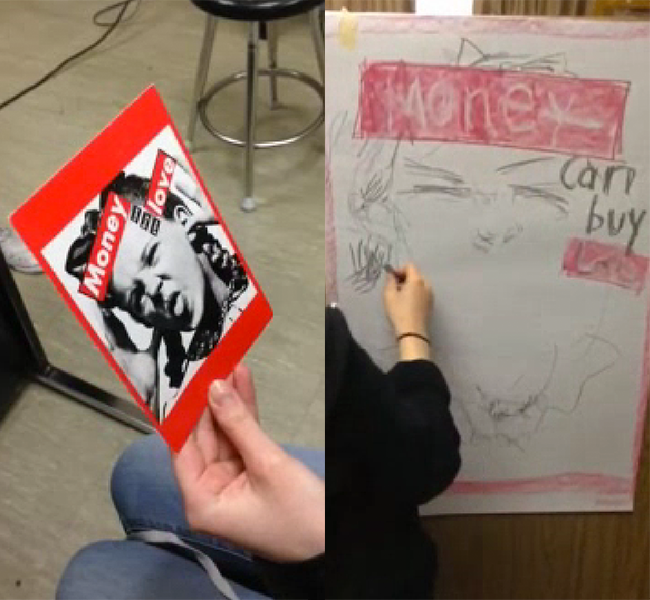
Students dictating and drawing Barbara Kruger’s Untitled (Money can buy you love), 1985.
This creativity exercise can be done for fun with a partner, or in a classroom to engage students in connecting with artworks on a fundamental level. While simultaneously honing viewing, listening, drawing, and attention skills, this activity is also great preparation for writing essays. The only materials required are paper, drawing utensils, and artwork postcards or prints (alternatively, students can find and print works from the Internet).
Pairs of students work together to recreate an artwork in the same way an egg-and-spoon race works: one ‘blindfolded’ team member is in charge of completing the task at hand (getting the egg safely to the finish line) while the other is responsible for directing them along the way. In this exercise, one partner selects a work and describes it while the other draws the work based on her partner’s descriptions alone.
Step 1: Find a partner and sit back-to-back. Decide who will draw and who will describe (from here on referred to as the Drawer and the Describer).
Sometimes instead of having pairs sit back-to-back, we flip the tables so that the top of the table can be used as a makeshift easel by the Drawers while the Describers face the table’s bottom. (But watch out for the legs!)
Step 2: The Describer chooses an artwork without letting the Drawer know which work was selected.
The selection of artworks can be limited according to the purposes of each class. The only parameter I give in my classroom is that the artwork must have been created in the last 50 years.
Students dictating and drawing Elizabeth Peyton’s Portrait of Piotr Uklanski, 1996.
Step 3: The Describer then describes his selected artwork while the Drawer sketches what she “sees” when listening to Describer’s explanation of the work. The Describer cannot see the Drawer’s design until the process is complete, but the Drawer is allowed to ask questions so that she is able to fill in all the details she needs.
There are also variations on this exercise that allow more or less flexibility, like allowing the Describer to watch the drawing as it’s developed, or not allowing the Drawer to ask questions at all.
Step 4: Once there’s nothing left in the image to describe and the Drawer is out of questions (usually after a half hour or so), the pair compares the original artwork with the Drawer’s depiction of it, noting the similarities and differences. Together, the partners discuss which parts of the description led to which parts of the drawing, while comparing both of these to the original artwork.
Step 5: Switch roles! The Drawer becomes the Describer, selecting a new artwork to explain to the new Drawer.
Often with older students I’ll change up the process when the pairs reverse roles, allowing the second Describer to watch the drawing as it’s being created. For more variation, you can place more parameters on the drawing. For instance, having the students draw a self-portrait no matter what, using the Describer’s characterizations to indicate the style of the self-portrait rather than the image itself (so if the Describer has selected a work by Piet Mondrian, the Drawer creates a Mondrian-styled self-portrait).
As long as students are learning to describe the image carefully, developing attention to detail and sustaining prolonged looking and contemplation of the artwork, the objectives of this exercise have been achieved. Share your experiences using this activity in the comments below!